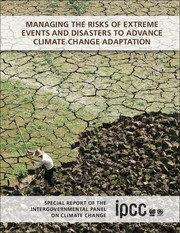 Managing the Risks of Extreme Events and Disasters to Advance Climate Change Adaptation
Managing the Risks of Extreme Events and Disasters to Advance Climate Change Adaptation Book contents
- Frontmatter
- Contents
- Section I
- Section II
- Section III
- Chapter 1 Climate Change: New Dimensions in Disaster Risk, Exposure, Vulnerability, and Resilience
- Chapter 2 Determinants of Risk: Exposure and Vulnerability
- Chapter 3 Changes in Climate Extremes and their Impacts on the Natural Physical Environment
- Chapter 4 Changes in Impacts of Climate Extremes: Human Systems and Ecosystems
- Chapter 5 Managing the Risks from Climate Extremes at the Local Level
- Chapter 6 National Systems for Managing the Risks from Climate Extremes and Disasters
- Chapter 7 Managing the Risks: International Level and Integration across Scales
- Chapter 8 Toward a Sustainable and Resilient Future
- Chapter 9 Case Studies
- Section IV
- Index
- References
Chapter 1 - Climate Change: New Dimensions in Disaster Risk, Exposure, Vulnerability, and Resilience
from Section III
Published online by Cambridge University Press: 05 August 2012
- Frontmatter
- Contents
- Section I
- Section II
- Section III
- Chapter 1 Climate Change: New Dimensions in Disaster Risk, Exposure, Vulnerability, and Resilience
- Chapter 2 Determinants of Risk: Exposure and Vulnerability
- Chapter 3 Changes in Climate Extremes and their Impacts on the Natural Physical Environment
- Chapter 4 Changes in Impacts of Climate Extremes: Human Systems and Ecosystems
- Chapter 5 Managing the Risks from Climate Extremes at the Local Level
- Chapter 6 National Systems for Managing the Risks from Climate Extremes and Disasters
- Chapter 7 Managing the Risks: International Level and Integration across Scales
- Chapter 8 Toward a Sustainable and Resilient Future
- Chapter 9 Case Studies
- Section IV
- Index
- References
Summary
Executive Summary
Disaster signifies extreme impacts suffered when hazardous physical events interact with vulnerable social conditions to severely alter the normal functioning of a community or a society (high confidence). Social vulnerability and exposure are key determinants of disaster risk and help explain why non-extreme physical events and chronic hazards can also lead to extreme impacts and disasters, while some extreme events do not. Extreme impacts on human, ecological, or physical systems derive from individual extreme or non-extreme events, or a compounding of events or their impacts (for example, drought creating the conditions for wildfire, followed by heavy rain leading to landslides and soil erosion). [1.1.2.1, 1.1.2.3, 1.2.3.1, 1.3]
Management strategies based on the reduction of everyday or chronic risk factors and on the reduction of risk associated with non-extreme events, as opposed to strategies based solely on the exceptional or extreme, provide a mechanism that facilitates the reduction of disaster risk and the preparation for and response to extremes and disasters (high confidence). Effective adaptation to climate change requires an understanding of the diverse ways in which social processes and development pathways shape disaster risk. Disaster risk is often causally related to ongoing, chronic, or persistent environmental, economic, or social risk factors. [1.1.2.2, 1.1.3, 1.1.4.1, 1.3.2]
Development practice, policy, and outcomes are critical to shaping disaster risk (high confidence). Disaster risk may be increased by shortcomings in development. Reductions in the rate of depletion of ecosystem services, improvements in urban land use and territorial organization processes, the strengthening of rural livelihoods, and general and specific advances in urban and rural governance advance the composite agenda of poverty reduction, disaster risk reduction, and adaptation to climate change. [1.1.2.1, 1.1.2.2, 1.1.3, 1.3.2, 1.3.3]
Information
- Type
- Chapter
- Information
- Managing the Risks of Extreme Events and Disasters to Advance Climate Change AdaptationSpecial Report of the Intergovernmental Panel on Climate Change, pp. 25 - 64Publisher: Cambridge University PressPrint publication year: 2012
References
Accessibility standard: Unknown
Why this information is here
This section outlines the accessibility features of this content - including support for screen readers, full keyboard navigation and high-contrast display options. This may not be relevant for you.Accessibility Information
- 189
- Cited by